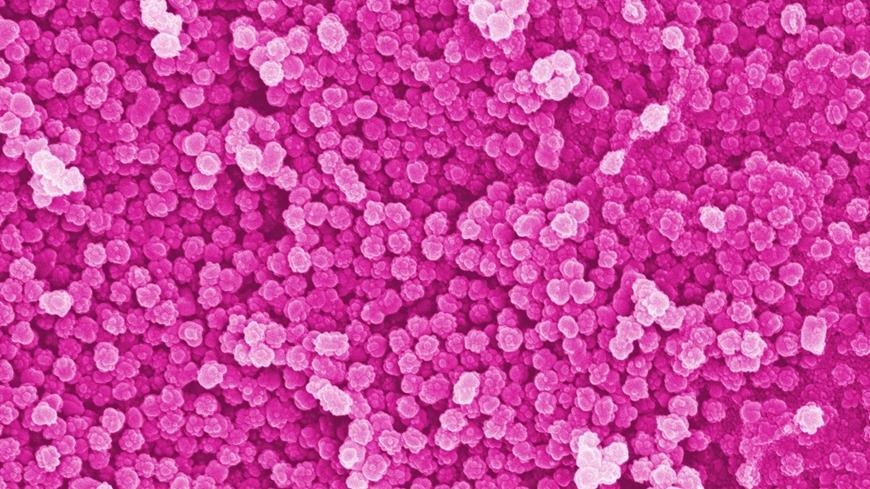May 5 2021
The images would definitely touch everyone: huge vortices of floating plastic trash in the global oceans with occasionally catastrophic consequences for their inhabitants—an overwhelming legacy of contemporary lifestyle.
 Nanoplastics: particles in the nanometer range (Electron microscopy image, colored, 50,000x). Image Credit: Empa/ETH.
Nanoplastics: particles in the nanometer range (Electron microscopy image, colored, 50,000x). Image Credit: Empa/ETH.
Innumerable tiny particles produced by weathering and degradation processes can now be identified in almost all ecosystems. However, the extent of the danger posed by the smallest of these particles—the so-called nanoplastics—is not known. But are these nanoplastics a ticking time bomb, as indicated by alarming media reports?
In the new issue of the Nature Nanotechnology journal, a team of researchers from Empa and ETH Zurich analyzed the state of present understanding—or lack thereof—and pointed out how these crucial queries should be addressed.
Wherever researchers look, they can detect nanoplastics. Whether in Arctic sea ice, in remote mountain lakes, in air samples, in the deep-ocean floor, or even in edible fish, there are scores of tiny plastic particles in the micrometer to millimeter range. Today, this microplastic is regarded as one of the defining traits of the Anthropocene—the age of the Earth molded by contemporary human beings.
Microplastics are created through weathering and biological and physicochemical degradation processes from macroscopic plastic products, like the huge amounts of plastic waste found in the oceans.
Such degradation processes are not likely to cease at the micrometer scale. And hence, there is a growing concern about the possible adverse effects of nanoplastics on numerous ecosystems.
Numerous media reports suggest, through their sometimes highly emotional coverage, that we are facing a huge problem here.
Bernd Nowack, Researcher, Empa
For a long time, Nowack has been studying the material flows of synthetic nano- and microparticles, for instance, from tire abrasion or textiles, into the environment. But according to Nowack, this statement can barely be validated by scientific findings.
“We don’t even know how much nanoplastics there is in the different ecosystems,” he added
Huge Gaps Knowledge
This is mainly because it is extremely challenging in terms of measurement technology to detect artificial nanoparticles composed of plastic in environmental specimens with an unlimited number of natural and similar-sized particles. Denise Mitrano from ETH Zurich stated that suitable analytical techniques would initially need to be developed.
If such techniques are developed, it would help understand the kind of risks posed by the microscopic plastic particles—a few of which vary significantly in their chemical composition—to the environment and human beings—or to put this in simple terms, how dangerous they ultimately are.
So we can’t justifiably say we have a serious problem here—but we also can’t say we don’t.
Bernd Nowack, Researcher, Empa
This is because if the particles become smaller, they are more likely to reach tissues and organs that are not accessible to bigger particles. For example, the blood-brain barrier or placenta prevents macromolecules from traveling through until they reach a specific size—or rather, smallness—thus preserving the tissues and organs “behind” them, that is, the brain and fetus, in that order, from possibly harmful substances, like bacteria and viruses.
Even if we ingest microplastics, for example through our food, they probably do not enter our bloodstream or our brain, but are simply excreted again. With nanoplastics, we can't be so sure.
Peter Wick, Head of Particles-Biology Interactions lab, Empa
Wick studies the interactions between nanoparticles and biological systems.
Great Need for Research
Due to huge gaps in present knowledge, nanoplastics studies should therefore be intensified, concluded Mitrano, Wick, and Nowack. But this should be carried out in a systematic manner and as extensively as possible, with a calm approach. After all, the emerging pollutants do not invariably become as harmful as originally believed.
“Our society initially adopts a zero-risk attitude toward many things that are new and unknown. And that’s understandable, he adds, especially in the case of nanoplastics, because, after all, ‘who wants plastic in their food?’” added Wick.
But the solution to this problem is both simple (at least at the theoretical level) and complex. On the one hand, a huge amount of nanoplastic particles are created by the degradation of micro- and macroplastics. This mean less plastic in the environment will decrease the number of nanoplastics, and in this regard, all individuals can help stop contaminating the environment with plastic waste.
On the other hand, nanoplastics can also be produced during the application of plastic products—for instance, via abrasion—without the users being able to do anything about it. But without plastic, society would hardly exist.
“The various polymers simply have too many positive properties for that,” concluded Nowack.
Journal Reference:
Mitrano, D. M., et al. (2021) Placing nanoplastics in the context of global plastic pollution. Nature Nanotechnology. doi.org/10.1038/s41565-021-00888-2.